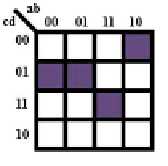Information Technology Reference
In-Depth Information
K-map implementation for f
¼
ab
0
c
0
d
0
þ
abcd
þ
ac
0
d
Fig. 9.
Fig. 10.
Solution based on K-map
selected, there is often little choice for the third primitive. The third primitive must
cover the on-set squares that are covered only once by the first two primitives and it
cannot cover the off-set squares that have been covered by the first two squares.
To summarize, any squares that are covered twice or more will be on-set in the
resulting K-map. Any squares that are covered only once or not covered by any
primitives will not be set in the resulting K-map.
Notice, not all the four-variable functions can be represented by only three
majority voters. After the first two primitives have been selected, it is possible that no
primitive can match the requirement to ''cover the on-set squares which are covered
only once by the first two primitives and don't cover the off-set squares which are
covered once by the first two primitives''. In this case, the required patterns can be
expanded to another level, and another three primitives will be needed. The expansion
of the level will lead to tree structure solutions for four variable logic functions.
For the example f = ab
0
c
0
d
0
+ abcd + ac
0
d, the primitive M(a, c
0
,d)(No. 79 in
Table
1
) is selected first because it covers more of the on-set squares and less of the
off-set squares as compared to other primitives. Then ''(a
0
)'' (No. 4 in Table
1
)is
selected as the second primitive. When trying to select the last primitive, it can be seen


Search WWH ::

Custom Search